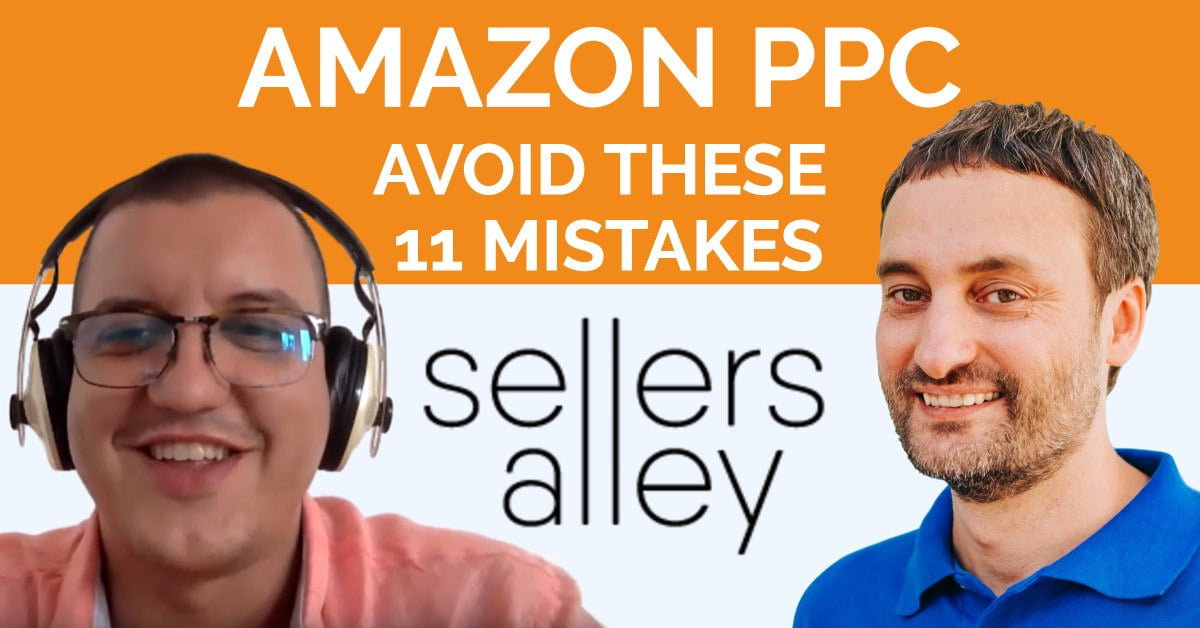What are the most common Amazon Sponsored Ads Mistakes and how to avoid it?
This time Lazar Zepinic from Sellers Alley talks about the most common mistakes he sees in Amazon sellers advertising accounts. These tips on how to avoid such mistakes are valuable for both beginners and advanced Amazon sellers trying to figure out their PPC accounts.
Lazar is the owner of Sellers Alley, Amazon PPC agency and has been a PPC Specialist for 9 years. Worked mostly on active advertising platforms with some of the biggest brands in the world including Samsung, Sony, and many others.
Given his knowledge on Amazon sponsored ads, Lazar will be one of the speakers at PPC Congress Amsterdam on October 3-4, where he will talk about the power of data. According to him, people tend to search for different software or applications that magically help them with improving their accounts. What those people don’t know is that they already have all the necessary information and with some basic knowledge of using Excel they can optimize their Amazon accounts and improve performance.
Meet Lazar at PPC Congress 2019 in Amsterdam: https://ppccongress.com/
Common mistakes in Amazon advertising accounts
These mistakes and tips on how to avoid it are valuable for both beginners and advanced Amazon sellers trying to figure out their PPC accounts.
04:14 Mistake #1: Bad Account Structuring
06:18 Mistake #2: Placing too high bids
07:41 Mistake #3: Placing all merch types in the same ad group
09:30 Mistake #4: Having different products in the same ad group
11:23 Mistake #5: No ASIN targeting campaigns
12:38 Mistake #6: No defensive campaigns
13:26 Mistake #7: Ignoring reports
18:12 Mistake #8: Neglecting A/B testing
20:42 Mistake #9: Having a lot of keywords in one ad group
21:51 Mistake #10: Ignoring different date ranges
23:27 Mistake #11: Neglecting negative keywords
1. Bad account structuring
When you have your brand on Amazon and want to create ads, you want to create brand awareness, the main keywords to show up and rank better for those keywords. If you are just a beginner, you would want to find some longtail keywords with less competition to get more traffic. When it all comes to Amazon accounts, lots of campaigns are missing some of those things.
The problem is lots of times sellers might consider if they really need to create a campaign with their brand name that people won’t recognize anyway? The truth is – it’s very important to have a brand campaign with your exact brand name, even though you are still unknown. Yes, you won’t get any sales or huge traffic from that campaign, because it takes time to finally get more traffic. However, eventually, people will get familiar with your brand and then your campaign starts to perform better and better.
Also, it’s crucial to protect your brand name so other sellers couldn’t use it. There are some different campaigns that should be placed in the account. One of them is a top generic campaign that uses main keywords instead of longtail keywords that are more recommended to use at the beginning stages.
2. Placing too high bids
Lazar sees a lot of accounts with dynamic bidding by placement at 900 % with full bids in their campaign. Lots of those people think they have a huge problem spending too much money through such campaigns. What they don’t really realize is that they managed to increase bid for nine times just because they placed 100 % percent dynamic bidding by placement for that campaign.
In this situation, Lazar recommends to place lower bid and place bidding by placement percentage for that specific placement and to target it.
Since it might be a bit tricky for beginning Amazon sellers, Lazar suggests keeping up with standard bids and then gradually getting it higher. Then if you finally notice that some specific placement works really well, you might want to create a specific campaign with lower bid and a huge increase for certain placement.

3. Placing all merch types in the same ad group
From first sight, it can seem logical since you have all the terms in one campaign. The thing is, when you want to place a higher bid for a certain merch, you should rank for a specific keyword. When you have all the merch types in the same ad group, you are not able to do so.
4. Having different products in the same ad group
Having different value products in the same ad group is not going to work. The reason is your products have different margins and you would want to optimize each of those products separately so have the exact CPA data of how much you are spending for each conversion.
Amazon has introduced category targeting, however, not many sellers are aware of its benefits. The important thing using this targeting is the refine option and try to target specific parts of the category, brand or star rating.
5. No ASIN targeting campaigns
When you don’t have huge amounts of money to invest in showing up your product in the first position but still want to steal best sellers’ sales, it’s most likely you are going to do it by targeting those ASINs through sponsored product ads.
For example, somebody saw your ad, clicked on it, saw your product, saw another product on your product listing and purchased it. So basically that ASINs stole your sale. And that is probably not a part of your plan.
What would you want to do in this situation is to target those ASINs and try to steal back the sale from them.

6. No defensive campaigns
As an Amazon seller, you would want to cross-target your products for several reasons: 1) to protect your listings from competitors, 2) to have your own products showing in your product listing. But you might ask – why should I send my customer from one listing to another?
When somebody buys a few different products from you, they all are going to show up in a “frequently bought together” section. And cross-targeting is the way to improve your chance to show up in this section.
7. Ignoring reports
Another huge mistake here – people don’t take data from their reports. It’s a pretty common thing to go into the account for the first time and not to see any reports ever created.
Most of the sellers might use different tools for keyword searching. However, what they don’t realize is that the best keywords are already in their accounts, more precisely – in the term reports.
What you should do with this term reports data is to find search terms that are converting, especially those that already converted two or more times. Then you might want to create keywords out of those terms and test it.
Also, there is a lot of data in Seller Central that is neglected when creating campaigns. If you are running headlines search ads in AMS, you want to take the data from Seller Central, harvest all the keywords and to show up on both platforms to take as much advertising space as possible.
When creating headline search ads, attribution plays a huge role. It means that, even though your ad didn’t convert any sales, most of the times it’s because it was a part of a sales funnel: somebody saw your ad, then later searched for the product and bought it. So by creating headline search ads, you introduce your product to a potential customer.
8. Skipping A/B testing
PPC is all about testing. As a seller, you might want to try everything to find the best strategy that works for you. For that, you need to test your titles, headlines, images that you display, and what product images – or even your brand logo – work the best.
To show a customer what quality product you are selling, you need to invest. That is why Lazar recommends to definitely run an AB testing to find out what sells the best: maybe a yellow product attracts more customers than the red one? And that’s just one of many tests that you can do.
9. Having a lot of keywords in one ad group
You create a campaign, you have 500 keywords in one ad group. In this case, when you go to your account to check what is going on, you might get surprised seeing that only 20-30 keywords are working, while the rest of them are just staying there without generating any sales.
What you should do is to take those keywords and create new ad campaigns for them, separating by the main word and type. In this case, you end up with having a lot of campaigns with a small amount with keywords which are, most importantly, working.

10. Ignoring different date ranges
Try to think differently – maybe something worked in the past, maybe something is working to slowly right now or you need two weeks to generate a bit of sales?
Look at different date ranges and you might see a lot of keywords spending lots of money and making no conversions. Even though those keywords cost you 1 or 2 dollars, having thousands of them will make you spend a lot for nothing.
Another type of keywords is those that generate sales but are not profitable. So if you, let’s say, check your account for the last 6 days and see that this keyword generated 1 sale, it might be misleading. Because if you check a longer period of time, for instance, a month, it can show you that this keyword generated only one sale. That’s something to be optimized!
11. Neglecting negative keywords
Negative keywords are very important for every Amazon account. These keywords help you with narrowing down your search funnels, so basically you don’t need to spend money on irrelevant search terms.
Ignoring negative keywords can trigger a lot of irrelevant search queries. So the only thing to do here is to again test what’s working and what’s not, try to structure and optimize your keywords.
To meet Lazar in person, join PPC Congress 2019 in Amsterdam on October 3-4: https://ppccongress.com/
Or mention ORANGE KLIK when contacting him at office@sellersalley.com
Find more on https://sellersalley.com
About Lazar Zepinic
Owner of Sellers Alley, Amazon PPC agency. Lazar has been a PPC Specialist for 9 years, worked mostly on active advertising platforms with some of the biggest brands in the world including Samsung, Sony, and many others. Right now he works with 7-9 figure Amazon sellers and has experience in optimizing multi-million accounts on both Seller Central and Amazon Advertising platforms.




